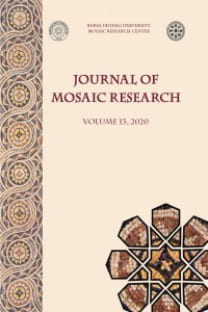Antakya’dan Bir Mozaik Üzerinde Melek Kanatlı Psykhe
Antakya, Traianus su kemeri evi, mozaik, Psykhe, Apuleius
The Psyche with Angel Wings on a Mosaic from Antioch
Antioch, House of the aqueduct of Trajan, mosaic, Psyche, Apuleius,
___
- Apul.met. Apulée, Les Métamorphoses ou l’Âne d’or, texte établi par D. S. Robertson et traduit par O. Sers, Paris 2007 (Les Belles Lettres, Classiques en poche 82).
- Baratte 1990 Fr. Baratte, « La vaisselle de bronze et d’argent sur les monuments figurés romains. Documents anciens et nouveaux », BAntFr (1990-1992), 89-108.
- Campbell 1988 S. Campbell, The Mosaics of Antioch, Toronto (Pontifical Institute for Medieval Studies; Brepols, Subsidia Mediaevalia 15).
- Cimok 2000 F. Cimok, Antioch Mosaics, a Corpus, İstanbul.
- Collignon 1877 M. Collignon, Essai sur les monuments grecs et romains relatifs au mythe de Psyché, Paris.
- DAGR Dictionnaire des antiquités grecques et romaines, Ch. Daremberg – E. Saglio (eds.), Paris (Hachette) s.v. lucerna, lychnus (λύχνος), J. Toutain, III.2 (1873), 1320-1339. s.v. velum (παραπέτασμα), V. Chapot, V (1892), 671-677.
- Darmon 2011 J.-P. Darmon, « L’épouse mystique de Zeugma : Ariane ou Psyché ? Encore une retractatio », BAntFr (2004-2005), 83-95.
- Darmon 2012 J.-P. Darmon, « Une énigme enfin résolue : la fausse Iphigénie d’Antioche était une Alceste », M. Şahin (ed.), 11th International Colloquium on Ancient Mosaics, October 16th-20th, Bursa-Turkey, 286-294.
- Décor I C. Balmelle – M. Blanchard Lemée – J. Christophe – J.-P. Darmon – A.-M. Guimier Sorbets – H. Lavagne – R. Prudhomme – H. Stern, Le Décor Géométrique de la Mosaïque Romaine I, Paris, 1985.
- Grimal (1951) 1999 P. Grimal, Dictionnaire de la mythologie grecque et romaine, Paris.
- Levi 1947 D. Levi, Antioch Mosaic Pavements Vol. I-II, Princeton.
- LIMC Lexicon Iconographicum Mythologiae Classicae, Zürich/München (Artemis) s.v. Psyché, N. Icard-Gianolio, VII (1994) I : 569-585 – II : 436-461.
- Önal 2007 M. Önal, Belkis/Zeugma and its Mosaics, İstanbul.
- Pepe 1959 L. Pepe, Per una storia della narrativa latina, Napoli (Armanni).
- Schlam 1976 C. Schlam, Cupid and Psyche: Apuleius and the Monuments, University Park, Pa (American Philological Association Pamphlets).
- Stillwell 1938 R. Stillwell, Antioch-on-the-Orontes, II, The Excavations 1933-1936, Princeton/London/The Hague.
- ISSN: 1309-047X
- Yayın Aralığı: 1
- Başlangıç: 2008
- Yayıncı: Ululdağ Üniversitesi, Mozaik Araştırlmaları Merkezi
Antakya’dan Bir Mozaik Üzerinde Melek Kanatlı Psykhe
Roma Mozaiklerinde Ulysses ve Polyphemus’un Temsili. Analizler ve Karşılaştırmalar
Suriye’nin Kuzeyinde in situ Yeni Osrhoene Mozaikleri
Komait ABDALLAH, Alain DESREUMAUX, Mohamad AL-KAİD
İsa’nın Mabede Takdimi Sahnesinin Görsel Anlatım Biçimleri Üzerine Bir Değerlendirme
Kitap İncelemesi: Corpus of the Roman Mosaics of the Conuentus Bracaraugustanus
Tarsus Roma Hamamı Geç Antik Opus Sectile Döşemesi
İsrail, Hazor-Ashdod Kilisesi’nin Mozaik Zeminleri
Philippopolis, Trakya’daki, İS 6. yüzyıl Mozaik Döşemeleri. Bazı Düşünceler
